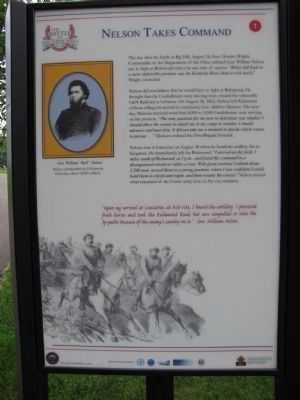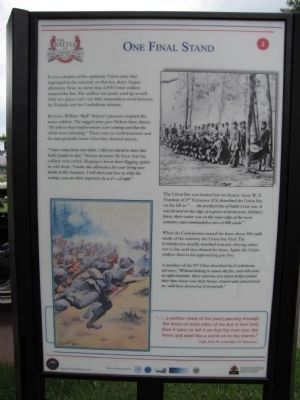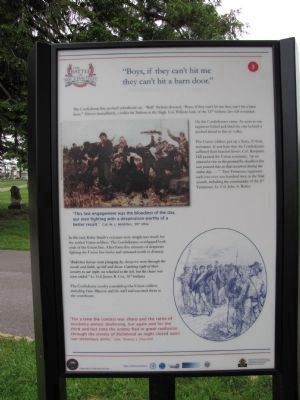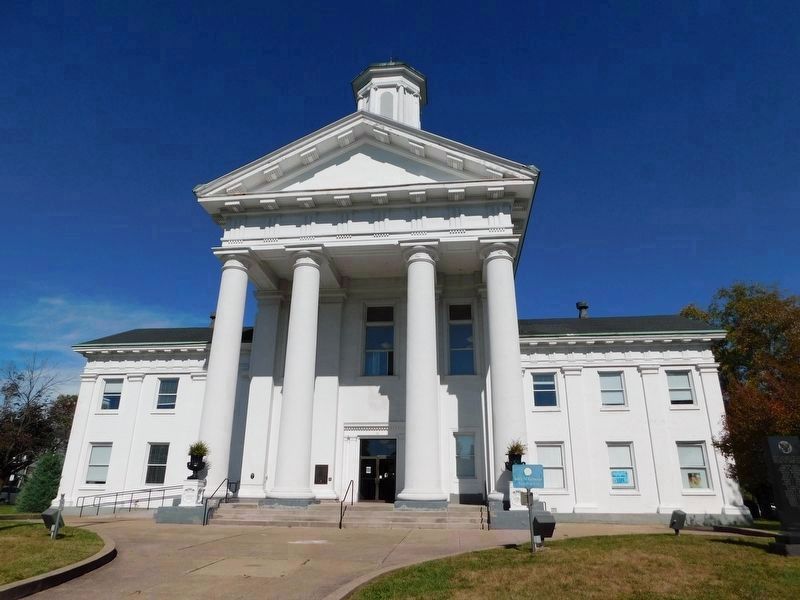Richmond in Madison County, Kentucky — The American South (East South Central)
Battle of Richmond
Kiosk 1
(Side 1):
Nelson Takes Command
The day after the battle at Big Hill, August 24, Gen. Horatio Wright, Commander of the Department of the Ohio, ordered Gen. William Nelson not to fight at Richmond unless he was sure of success. "Better fall back to a more defensible position, say the Kentucky River, than to risk much," Wright counseled.
Nelson did not believe that he would have to fight at Richmond. He thought that the Confederates were moving west, toward a more vulnerable L&N Railroad at Lebanon. On August 28, 1862, Nelson left Richmond without telling his second in command, Gen. Mahlon Manson. The next day, Manson received word that 4,000 to 5,000 Confederates were moving on his position. "The only question for me now to determine was whether I should allow the enemy to attack me in my camp or whether I should advance and meet him. It did not take me a moment to decide which course to pursue..." Manson ordered the First Brigade forward.
Nelson was in Lancaster on August 30 when he heard the artillery fire on Kingston. He immediately left for Richmond. "I arrived on the field, 3 miles south of Richmond, at 2 p.m., and found the command in a disorganized retreat or rather a rout. With great extertion, I rallied about 2,200 men, moved them to a strong position, where I was confident I could hold them in check until night, and then resume the retreat." Nelson moved what remained of the Union army here, to the city cemetery.
"Upon my arrival at Lancaster, at 9:30 AM, I heard the artillery. I procured fresh horses and took the Richmond Road, but was compelled to take the by-paths because of the enemy's cavalry on it." Gen. William Nelson
(Side 2):
One Final Stand
It was a shadow of the optimistic Union army that regrouped in the cemetery on that hot, dusty August afternoon. Now, no more than 2,500 Union soldiers manned the line. The artillery was pretty used up as well. Only two pieces with very little ammunition stood between the Federals and the Confederate infantry.
But Gen. William "Bull" Nelson's presence inspired the weary soldiers. The ragged army gave Nelson three cheers. "He told us that reinforcements were coming and that the rebels were retreating." There were no reinforcements and the men probably knew it but they cheered anyway.
"I have come forty-one miles; I did not intend to have this battle fought to-day," Nelson shouted. He knew that the soldiers were rattled. Hoping to boost their flagging spirits he told them, "I make due allowance for your being new hands at this business; I will show you how to whip the scamps; you are their superiors by a d---d sight."
The Union line was bruised but not beaten. Lieut. W.E. Yeatman of 2nd Tennessee (CS) described the Union line on the hill as "...the prettiest line of battle I ever saw. It was formed on the edge of a grove of forest trees, behind a fence, their center was on the outer edge of the town cemetery and commanded a view of 800 yards."
When the Confederates neared the fence about 300 yards south of the cemetery the Union line fired. The Confederates steadily marched forward, obeying orders not to fire until they cleared the fence. Again, the Union soldiers fired at the approaching gray line.
A member of the 95th Ohio described the Confederate advance, Without halting to return the fire, and with arms at right-shoulder, these veterans of a dozen battles pulled their hats closer over their brows, closed ranks, and pressed on, with lines dressed as if on parade."
"...a perfect sheet of fire [was] passing through the fence on both sides of me but in less time than it takes to tell it we had the men over the fence and went like a storm on to the enemy." Capt. John W. Lavender, 4th Arkansas
(Side 3):
"Boys, if they can't hit me they can't hit a barn door."
The Confederate line pushed relentlessly on. "Bull" Nelson shouted, "Boys, if they can't hit me they can't hit a barn door." Almost immediately, a bullet hit Nelson
in the thigh. Col. William Link of the 12th Indiana also fell wounded.
On the Confederates came. As soon as one regiment halted and fired the one behind it pushed ahead to fire its volley.
The Union soldiers put up a fierce, if short, resistance. It was here that the Confederates suffered their heaviest losses. Col. Benjamin Hill praised the Union resistance, "as we cleared a rise in the ground the deadliest fire was poured into us that occurred during the entire day...." Two Tennessee regiments each lost over one hundred men in the final assault, including the commander of the 2nd Tennessee, Lt. Col. John A. Butler.
In the end, Kirby Smith's veterans were simply too much for the rattled Union soldiers. The Confederates overlapped both ends of the Union line. After forty-five minutes of desperate fighting the Union line broke and retreated north in disarray.
"Riderless horses went plunging by. Away we went through the woods and fields, up hill and down. Catching sight of their cavalry to our right, we wheeled to the left, but the chase was soon ended." Lt. Col. James R. Cox, 16th Indiana
The Confederate cavalry rounded up Union soldiers including Gen. Manson and his staff and escorted them to the courthouse.
"For a time the contest was sharp and the rattle of musketry almost deafening, but again and for
the third and last time the enemy fled in great confusion through the streets of Richmond as night closed upon our victorious arms." Gen. Thomas J. Churchill
Erected by Civil War Discovery Trail.
Topics. This historical marker is listed in this topic list: War, US Civil. A significant historical year for this entry is 1862.
Location. 37° 44.613′ N, 84° 17.432′ W. Marker is in Richmond, Kentucky, in Madison County. Marker can be reached from East Main Street (U.S. 25) 0.1 miles west of Wicker Lane, on the left when traveling west. Marker is in the Richmond Cemetery, approximately 0.1 miles from the main entrance. Touch for map. Marker is in this post office area: Richmond KY 40475, United States of America. Touch for directions.
Other nearby markers. At least 8 other markers are within walking distance of this marker. In Memory Of The Fallen Union And Confederate Soldiers (within shouting distance of this marker); In Memory Of The Confederate Soldiers (within shouting distance of this marker); Cassius Marcellus Clay (about 400 feet away, measured in a direct line); Medal of Honor Winners (about 600 feet away); Pioneer Monument (approx. 0.3 miles away); Madison County Courthouse 1862 (approx. 0.4 miles away); Samuel Freeman Miller (approx. 0.4 miles away); County Named, 1786 / County Formed (approx. 0.4 miles away). Touch for a list and map of all markers in Richmond.
Credits. This page was last revised on February 21, 2021. It was originally submitted on June 1, 2010, by Lee Hattabaugh of Capshaw, Alabama. This page has been viewed 935 times since then and 13 times this year. Last updated on June 2, 2010, by Lee Hattabaugh of Capshaw, Alabama. Photos: 1, 2, 3. submitted on June 1, 2010, by Lee Hattabaugh of Capshaw, Alabama. 4. submitted on February 21, 2021, by Bradley Owen of Morgantown, West Virginia. • Craig Swain was the editor who published this page.



